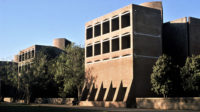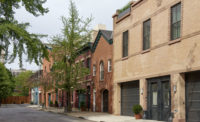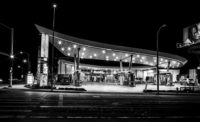The Conrad Washington DC by Herzog & de Meuron / Rottet Studio
Washington, D.C.

The Conrad Hotel in Washington, D.C., is part of the CityCenter mixed-use development. Photo © Eric Petschek
The nation’s capital is famous for its stately hotels, palatial brick and limestone piles with paned windows framed by passementerie-laden curtains. The Conrad Washington DC, part of the luxury portfolio of Hilton, brings a vastly different design approach—a modern elegance—with such distinctive features as floor-to-ceiling glass walls in the guest rooms, a soaring, sinuously curved skylit atrium, landscaped terraces adjacent to a bar and a café on the third floor, and a roof garden topping its 10 stories.


The architects sculpted a skylit atrium with chain mesh over limed oak walls. The undulating contours of the atrium add mystery. Photos © Eric Laignel, click to enlarge.
The Conrad is in CityCenter, the 10-acre mixed-use complex on the site of Washington’s old Convention Center. Hines, the project developer, hired the Swiss firm Herzog & de Meuron as design consultant, and brought in Houston-based Rottet Studio, led by architect Lauren Rottet, as interior designer, with HKS as the executive architect.

View of Atrium at Fourth Level. Photo © Eric Laignel
Along the northern edge of this complex, the hotel sits on a prominent wedge-shaped lot on the diagonal New York Avenue, which cuts through the city’s orthogonal grid. For the Conrad, seeking to offer a luxury-business ambience without charging an arm and a leg, the team needed to provide 360 guest rooms, plus dining facilities, shops, and 32,000 square feet of conference and event space, as well as parking, all in a 466,000-square-foot post-tensioned concrete-framed structure.
Herzog & de Meuron’s sleekly streamlined object is like a sculpture perched on an asymmetrical pedestal: the two-story base almost fills out the irregular site, while the floors above are fashioned into an unusual shape, dictated by the plan. The entirety is sheathed in shimmering glass: at the street level, curved convex bays activate the facade for the retail shops, including Tiffany. The second floor of the podium contains the ballrooms and event spaces, enclosed by glass walls that bring light and views into typically windowless venues often relegated to the basement.

Blue columns indicate Tiffany’s location on the ground level, with event spaces above in the two-story base. Photo © Eric Laignel
On the third floor, drama and dynamics take over. Here the public spaces—including a reception desk, bar/lounge, and restaurant, are arrayed around an atrium that majestically soars up 100 feet to a cluster of circular skylights embedded in the roof. The towering space is wrapped in diaphanous steel mesh, draped in front of curvilinear walls of limed oak in some areas, and elsewhere, as merely a scrim to conceal—yet reveal—the guest room corridors ringing the atrium’s upper levels. As Ascan Mergenthaler, Herzog & de Meuron’s partner in charge, says, “The usual big atria you see in hotels are repetitive and not interesting. We wanted a divine space—a column of light surrounded by a veil.”

1

2
On the third level is the hotel reception and the bar/lounge near the skylit atrium (1). Contemporary and Early American–style furnishings (2) enliven the mix. Photos © Eric Laignel
Within this gently swirling vortex is suspended a large, circular pendant, which the architects conceived as a displaced moon. Regulated by dimmers and lighting controls, its hues and brightness give off a glow during the day and evening. Rottet emphasized the voluptuousness of the light-filled atrium by inserting serpentine sofas and chairs between the curving folds of the backdrop. Elsewhere in the public areas and guest rooms she favored furnishings and finishes that slyly allude to the history of the capital by subtly evoking Early American furnishings. Wingback and spindle-back chairs, or a modified version of the four-poster bed, are mixed with contemporary design. Walnut furniture and oak paneling add warmth to spaces throughout the hotel, in contrast to the glistening black-and-white marble sheathing the lobby’s walls and floors. Generally the color scheme ranges from warm beige to taupe or gray. In the guest rooms, layers of opaque and sheer curtains in muted tones open at the touch of a button to the panorama of the city beyond. Since Washington has a strict building-height limit, that view takes in a lot of city and sky.


Guest rooms are spacious. Photos © Eric Laignel
To ensure such vistas would be available to all the rooms, Mergenthaler points out that you need to have many perimeter surfaces. His team developed a plan above the two-story base inspired by the diagonal of New York Avenue. It looks like a bow tie waiting to be knotted: the public areas on the third level and guest quarters above are arrayed around the void of the atrium the way a tie loops around a man’s neck, the two ends crossing and continuing in two diagonal directions—one “band” heading to the southeast corner of the building, the other to the northeast (see plans, opposite). Each has double-loaded corridors of guest rooms, all meeting the goal of offering uninterrupted expanses of glass. The bow tie plan for these quarters not only resulted in the varied room shapes, but helped to generate some admirably short hallways.
The idiosyncratic layout creates indented triangular spaces that have been transformed into outdoor landscaped terraces on the third floor, above the busy streets. One garden adjoins the bar on the north, the other a café on the south, while a third area on the east is yet to be determined.

An ambulatory runs around the perimeter of the second-floor meeting spaces. Photo © Eric Laignel
The two-story base has five unequal sides, and on the second floor, the event rooms’ plan takes advantage of this peculiarity: an ambulatory space separates these areas from the glazed perimeter walls, which are punctuated by a row of exposed concrete columns. While strolling around the circumference, a visitor is projected visually into the city until circling back to the lounge, where the rear wall of curved oak parts for the stair to the bar above. An exposed steel truss on the north side of the lounge attests to the “engineering gymnastics” —as project director Philip Schmerbeck puts it—that were needed for the recessed entrance’s porte-cochere underneath to be column-free. Elsewhere, steel transfer beams aid in the transition of loads from the upper floors to the base.

Event space lobby on the second level. Photo © Eric Laignel
Clearly, placing the event spaces on the second floor was not easy. But the access to daylight should make the hotel a desirable venue for meetings once the pandemic is over. At this time, with business travel yet to resume, the hotel is nevertheless attracting guests who desire rooms with a view, svelte but comfortable furnishings, plus a bar/lounge with social distancing. The Conrad’s appeal to this audience has everything to do with the design; in a city of stolid hotels and largely conservative architecture, its ingenious scheme, in plan and section, sets it apart. And, as Washington is known for its seductions (political and otherwise), it is refreshing to discover a soigné stage set that emblematizes that allure.

Click plans to enlarge

Click plans to enlarge
Credits
Design Consultant:
Herzog & de Meuron — Jacques Herzog, Pierre de Meuron, founding partners; Ascan Mergenthaler, partner in charge; Vladimir Pajkic, partner; Philip Schmerbeck, associate, project director
Interior Architect:
Rottet Studio — Lauren Rottet, founding principal and lead designer; David Davis, founding principal and managing partner; Anja Majkic, associate principal and design director
Executive Architect:
HKS — Jeff Vandersall, principal in charge
Engineers:
MEP Consultant: Dewberry
Structural Consultants, Superstructure: Thornton Tomasetti
Structural Consultants, Subgrade: A+F Engineers
Civil Consultant: Delon Hampton
Geotechnical Engineering: Schnabel Engineering Consultant
Consultants:
Purchasing Agent: Parker International
Lighting Designer: MCLA
Landscape Design Architect: Gustafson Guthrie Nichol
LEED Consultant: GreenShape LLC
Stone Consultant: Ramsey Stone Consultants
Technology Consultant: RTKL
Landscape Streetscape: Lee & Associates, Inc.
Curtainwall Consultant: Curtainwall Design Consulting (CDC)
Graphic Consultant: Unison Agency
Security/BMCS: HMA Consulting
Vertical Transportation: Persohn/Hahn Associates, Inc.
Life Safety: ARUP
Kitchen Consultant: SDI
Exterior Building Maintenance Consultant: Applied Technical Services, Inc. (ATS)
Hotel Consultant: Colliers PKF Consulting
Legal: Baker Botts LLP; Paul Hastings LLP
Parking Consultant: HWA Parking
Zoning: Goulston and Storrs
General contractor:
Turner Construction Company
Curtainwall Contractor:
TSI Exterior Wall Systems, Inc.
Client:
Hilton
Owner:
Hines
Size:
466,000 square feet
Cost:
$250 million
Completion Date:
October 2019
Specifications
Glass:
Archetype Frameless Glass; Bendheim; Galaxy Glass
Skylights:
United Skys
Curved Glass:
Cristacurva
Curved Glass and Curtain Wall System:
Baker Metal Products;
Lighting Controls:
Lutron (public spaces); Honeywell (guest room)
Convex curved glass IGU:
Christacurva
Precast concrete:
Baker DC
Wood:
EIFS, ACM, or other:
Roofing:
Hydrotech Monolithic Membrane
Glazing:
Glass: Archetype Frameless Glass; Bendheim; Galaxy Glass
Skylights: Circular Metal Skylights by United Skys Inc.
Doors:
Entrances: Dormakaba – hotel revolving door
Metal doors: DeLaFontaine
Wood doors: Precision Doors and Hardware
Sliding doors: Eggers Industries
Fire-control doors, security grilles: Raynaers Doors
Hardware:
Locksets: Allegion
Closers: Rixson; Allegion
Exit devices: CRL-Blumcraft; Von DuprinPulls: CRL-Blumcraft; Burns
Interior Finishes:
Acoustical ceilings: Ecophon
Demountable partitions: ModernFold
Cabinetwork and custom woodwork: Beaubois
Paints and stains: Sherwin Williams
Wall coverings: Koroseal, Arbor SeriesPaneling: Grand and Junior Ballroom millwork – Beaubois
Floor and wall tile: Janeiro
Carpet: Couristan
Public Atrium Curtain: Custom stainless steel curved curtain design fabricated by Alphamesh
Wood flooring: Wide plank flooring
Furnishings:
Fixed seating: Beaubois
Lighting:
Interior ambient lighting: Lumid – Architectural Lighting: Moonlight – Atrium Pendant; and 2nd level waiting area
Downlights: LF Illumination; Elite Lighting; Oracle Lighting; Maxilume
Exterior: Elite Lighting; Oracle Lighting
Dimming system or other lighting controls: Lutron – Public Spaces, BOH; Honeywell – Guestroom Controls
Conveyance:
Elevators/escalators: Otis





